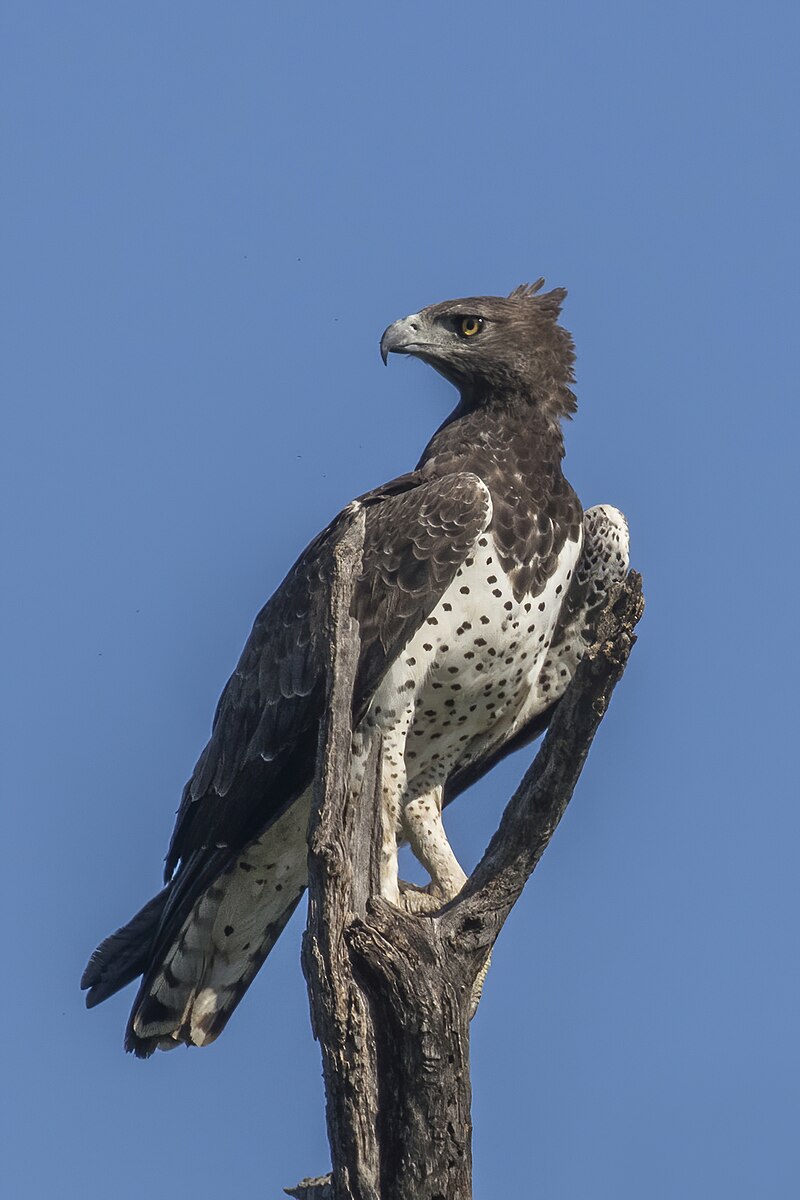The Martial Eagle (Polemaetus bellicosus) is a large bird of prey that inhabits open woods, woodland edges, wooded savannah, and thornbush habitats in sub-Saharan Africa. These powerful hunters are known to avoid closed-canopy forests and hyper-arid deserts, but can adapt to more open habitats such as semi-desert and open savanna with scattered trees.
The Preferred Habitat of the Martial Eagle
Martial eagles are found in the following habitats:
- Open woods and woodland edges
- Wooded savannah
- Thornbush habitats
- Semi-desert and open savanna with scattered trees
- Wooded hillocks
They typically prefer desolate or protected areas and avoid areas with moderate to heavy cultivation or with heavier or more consistent winter rainfall.
Elevation and Geographical Range
 Image source: Martial eagle by Charles J. Sharp
Image source: Martial eagle by Charles J. Sharp
Martial eagles have been recorded at elevations of up to 3,000 m (9,800 ft), but they are not a true mountain-dwelling species. Their geographical range spans sub-Saharan Africa, with populations found in various parts of the continent.
Behavioral Adaptations to the Habitat
Martial eagles are solitary birds and do not tolerate other eagles in their territory outside of the breeding season. They are generally shy and try to avoid humans, but may be seen passing over populated areas at times. These birds are relatively quiet, producing vocalizations such as ‘hlueee-oh’ when near the nest or excited, and a series of ‘klee-klee-klee-kloeee-kloeee-kulee’ during display.
Nesting and Breeding Habits
Martial eagles form monogamous pairs that stay together for life. They build their nests in large trees, usually placing them in the main fork of the tree at 6-20 m (20-66 ft) off the ground. Females typically lay one egg (rarely two) every two years, and the newly hatched chicks are initially quite weak and feeble, becoming more active only after they are 20 days old. The chicks usually first feed themselves at 9 to 11 weeks old and fledge at 96 to 109 days. They may remain in the care of their parents for a further 6 to 12 months and will reach reproductive maturity at 4 to 5 years of age.
Prey and Hunting Behavior
Martial eagles are carnivorous opportunistic predators that prey on a variety of animals, including:
- Small antelopes
- Some monkeys
- Young domestic goats and lambs
- Water birds such as herons, storks, and geese
- Monitor lizards
- Venomous snakes
- Jackals
- Medium-sized wild cats
These powerful hunters use their keen eyesight and agility to spot and capture their prey, often swooping down from a high perch or soaring above the ground.
Threats and Conservation Status
The main threats to Martial eagles include hunting and habitat loss. Farmers sometimes kill the birds because they hunt domestic animals, and the eagle’s low reproductive rate is also a problem for its long-term survival. According to the Africa Geographic resource, the total population size of the Martial eagle is approximately 30,000 individuals, and currently, Martial eagles are classified as Endangered (EN) on the IUCN Red List, with their numbers today decreasing.
Conclusion
The Martial Eagle is a remarkable bird of prey that has adapted to the open woodlands, savannas, and semi-desert habitats of sub-Saharan Africa. These solitary and shy hunters play a crucial role in the ecosystem, but they face threats from hunting and habitat loss. Continued conservation efforts are essential to ensure the long-term survival of this impressive species.
References:
– Wikipedia – Martial Eagle
– Animalia – Martial Eagle
– Kruger Park – Martial Eagle
– Animal Diversity Web – Martial Eagle

